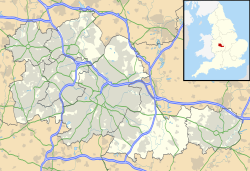History
From around 850 until the mid-1500s, the manor was home to the Grindlay family, who built the original moated manor house and accompanying outbuildings. [10] [11] Although after the conquest of 1066 the manor came under Norman overlordship, the family remained as vassals of the Picquigny, Paganell and then Somery families, the feudal barons of Dudley. [12] [13]
In 1338 the overlordship of the manor passed to the Botetourt family, until in 1370 when Sir John Botetourt settled it on Sir Hugh Segrave and his wife Isabel, who later married Sir Thomas Blount upon his death. [1] In 1390 a settlement between Sir Thomas and Sir Hugh Burnell joined the manors of Bordesley and Haybarn, henceforward linking them together. Thereafter the manor passed through the same ownership and divisions as the overlordship of the other manors in Aston parish. [2]
The Arden family held the manor from 1563 to 1643 until Robert Arden died without issue, leaving his four sisters as coheirs, namely Elizabeth, wife of Sir William Poley of Boxstead Hall, Godith, wife of Herbert Price, Dorothy, wife of Hervey Bagot of Pype Hayes Hall, and Anne, wife of Sir Charles Adderley of Lea. In 1706, the quarter conveyed to Elizabeth was purchased by Sir Charles Holte, 3rd Baronet, after which the manor descended with the Holte family along with that of Aston. [1] [2]
By the 18th century the manor was in the possession of John Taylor, [14] the Warwickshire manufacturer and banker, who rebuilt the house, enlarged and emparked the estate and created an ornamental pool with an island, bridge, and grotto at a cost of around £10,000. [1] On his death in 1785, the property passed to his son John and his wife Sarah Skeye, whose seven children were all born at the hall. In 1786, John Taylor Jr. was appointed High Sheriff of Warwickshire like his father before him. [15]
The house was burned down in 1791 during the Priestley Riots. [16] [17] Taylor claimed £12,670 as damages and was paid £9,902, but the historian William Hutton recorded that "the real loss of Mr Taylor amounted to upwards £22,600," [18] or approximately £3 million today (2022). [19]
“Hearing Mr. Taylor's house was in danger, they marched to Bordesley, one mile, to save it, but found another mob had begun to rob and burn it. At midnight I could see from my house the flames of Bordesley hall rise with dreadful aspect" – William Hutton, A Narrative Of The Riots In Birmingham, 14 July 1791
The house was reportedly rebuild, but Charles Pye Sr. writing of his visit to Birmingham in 1818 states:
"Having crossed the Warwick canal, the ruins of Bordesley house are in full view; they having continued in that state ever since the year 1791, when the house was demolished by an infuriated mob. The land by which it is surrounded has been parcelled out, and advertised to be let for building." [20] – Charles Pye, 1820
In 1840 the remaining house and lands were sold off for housing developments.
This page is based on this
Wikipedia article Text is available under the
CC BY-SA 4.0 license; additional terms may apply.
Images, videos and audio are available under their respective licenses.



